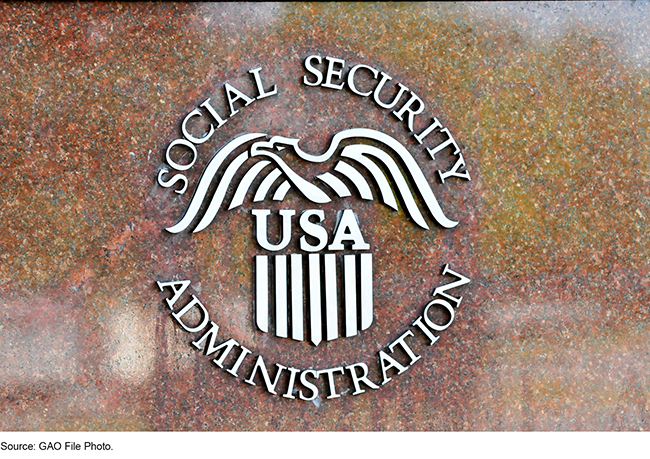Supplemental Security Income: SSA Faces Ongoing Challenges with Work Incentives and Improper Payments
Fast Facts
The Social Security Administration is trying to encourage people with disabilities who get Supplemental Security Income benefits to work if they can.
But we testified that working beneficiaries are at a higher risk of benefit overpayments. Beneficiaries who can work may choose not to because they're afraid of being stuck with overpaid benefits that they have to repay.
SSA hasn't resolved its lags in processing beneficiaries' earnings information—which can lead to overpayments even if the earnings were reported on time.
Also, SSA hasn't measured the effectiveness of how it deals with payment errors, despite our priority recommendation to do so.

Highlights
What GAO Found
The Social Security Administration (SSA) has undertaken several efforts to encourage employment for individuals with disabilities who receive Supplemental Security Income (SSI) and who would like to work, but few benefit from these supports.
- Work incentives and supports for transition-age youth. SSA administers work incentives and other employment supports for transition-age youth (ages 14 to 17) on SSI. These supports encourage work by allowing these youth to keep at least some of their benefits even if they have earnings. In 2017, GAO analysis of SSA data from 2012 to 2015 found that less than 1.5 percent of SSI youth benefitted from these incentives. According to SSA and other officials, this may be because SSI youth and their families are often unaware of or do not understand the incentives, and may fear that work will negatively affect their benefits or eligibility.
- Work incentives for working-age adults. The Ticket to Work and Self-Sufficiency Program (Ticket) is a voluntary program that was established to assist individuals with disabilities in obtaining and retaining employment, and help reduce dependency on benefits. Preliminary GAO analysis of Ticket indicates that SSI recipients participated more often than other disability beneficiaries, and benefited modestly from the program. GAO analysis of SSA data from 2002 to 2015 found, 5 years after participating in Ticket, about 4 percent of SSI participants had left the disability rolls due to earnings from work, compared with 2 percent of nonparticipants who were similar in characteristics such as age, disability type, and education. However, earnings for SSI Ticket participants remained low. GAO's analysis of data from 2002 to 2018 shows that average earnings for SSI Ticket participants, 5 years after participating, were $3,940 per year, including 57 percent who did not report any earnings at all. GAO's preliminary work also indicates that Ticket participants face a number of challenges to returning to work, including their primary disabling condition, which may not improve sufficiently to allow for fulltime employment, and disincentives to work such as the loss of cash and medical benefits.
Prior and ongoing GAO work has identified issues with SSA's efforts to reduce improper payments, including overpayments, to SSI beneficiaries in general and beneficiaries who are working in particular. Overpayments can occur when beneficiaries who work do not timely report earnings to SSA or SSA delays in adjusting their benefit amounts. SSA reported that SSI's overpayment rate in fiscal year 2019 was estimated at 8.13 percent, higher than other SSA programs. Further, SSA reported it made approximately $4.6 billion in SSI overpayments in fiscal year 2019. Overpayments may have to be repaid, which may be burdensome for recipients, especially those who were not aware that they were overpaid and already spent the money. While SSA has taken steps to reduce overpayments, SSA's Office of Inspector General found that SSA had not resolved lags in updating information on beneficiaries' earnings. In addition, SSA has not implemented a 2020 GAO priority recommendation that it develop and implement a process to measure the effectiveness of its corrective actions for improper payments, including overpayments.
Why GAO Did This Study
SSI is a federal assistance program administered by SSA that provides cash benefits to certain individuals who are elderly, blind, or have a disability. SSI acts as a safety net for individuals who have limited resources and little or no other income. As such, SSI is a means-tested program. As of July 2021, approximately 71 percent of SSI beneficiaries were children or working-age individuals with disabilities. SSA faces longstanding challenges related to administering SSI and its other disability programs. GAO has issued multiple reports with recommendations on how SSA might address these challenges.
This testimony describes SSA's challenges with (1) incentivizing employment for SSI recipients who wish to work, and (2) preventing improper payments to SSI recipients, including overpayments.
This statement is based primarily on prior GAO reports issued between 2010 and 2021, as well as preliminary observations from an ongoing GAO review of the Ticket program. To conduct the work for these reports and the ongoing review, GAO used a variety of methods including analyzing data; reviewing relevant federal laws, regulations, and guidance; reviewing key agency documents, such as SSA's strategic plan and annual SSI stewardship reports; and interviewing experts and SSA officials.
For more information, contact Elizabeth H. Curda at (202) 512-7215 or curdae@gao.gov.
